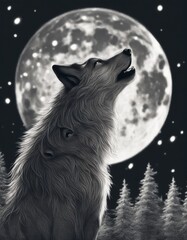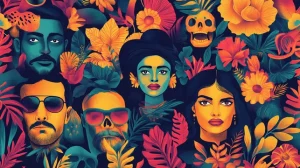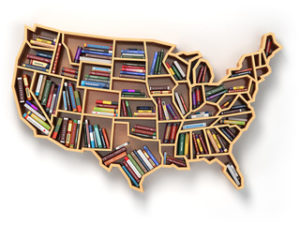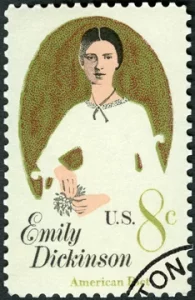 The term “Native American Literature” relates to the stories of the natives of the New World. North and South America are known as the “New World”. The term originated because of European voyages across the Atlantic Ocean. The Europeans discovered the two continents in the late 15th century. The expression “Native American Literature” in the real sense is a misnomer since the natives of the “New World” didn’t have writing traditions. There was no established alphabet or language in which the native tribes across the continents could write their stories.
The term “Native American Literature” relates to the stories of the natives of the New World. North and South America are known as the “New World”. The term originated because of European voyages across the Atlantic Ocean. The Europeans discovered the two continents in the late 15th century. The expression “Native American Literature” in the real sense is a misnomer since the natives of the “New World” didn’t have writing traditions. There was no established alphabet or language in which the native tribes across the continents could write their stories.
On the contrary, the Native Cultures had oral traditions. A story would be passed down from one generation to another orally. It would be told by a storyteller, usually around a campfire at night. The stories were often tweaked while storytelling, with each storyteller adding his or her spin to it with unique gestures such as tone and other alterations to make it more interesting and spicy and even more probing in terms of the story details. The central theme of the story however remained intact and was given a new look and feel with each generation of storytellers.
 Umpteen parallels are available in history about oral traditions, later adopted into scripts. For example, scholars have debated if ‘Beowulf’ , an old English epic poem in the tradition of Germanic heroic legend, was initially transmitted orally. Beowulf was written mostly in the Late West Saxon dialect of Old English. In the 13th century, Genghis Khan did not permit military information to be written down; it had to be delivered orally. The messengers therefore had to learn to compose and recite military orders through “rhetorically ornate rhyming words and cryptic expressions”. Concurrently, the government used the Mongolian language written in Uighur script for non-military mundane affairs because they had no script of their own, so even borrowed scripts were in vogue. The Uighurs had extensive libraries of hand-copied manuscripts translated from Sanskrit, but under the Mongols, many Tibetan manuscripts were also translated into Uighur script. From the beginning of the 13th century, the Uighur script was adopted as the official script of the Mongol empire.
Umpteen parallels are available in history about oral traditions, later adopted into scripts. For example, scholars have debated if ‘Beowulf’ , an old English epic poem in the tradition of Germanic heroic legend, was initially transmitted orally. Beowulf was written mostly in the Late West Saxon dialect of Old English. In the 13th century, Genghis Khan did not permit military information to be written down; it had to be delivered orally. The messengers therefore had to learn to compose and recite military orders through “rhetorically ornate rhyming words and cryptic expressions”. Concurrently, the government used the Mongolian language written in Uighur script for non-military mundane affairs because they had no script of their own, so even borrowed scripts were in vogue. The Uighurs had extensive libraries of hand-copied manuscripts translated from Sanskrit, but under the Mongols, many Tibetan manuscripts were also translated into Uighur script. From the beginning of the 13th century, the Uighur script was adopted as the official script of the Mongol empire.
 Some cultures did have a system of written traditions like the Aztecs, now more or less an extinct language. Some cultures used hieroglyphics and pictographic drawings to record important stories and messages.
Some cultures did have a system of written traditions like the Aztecs, now more or less an extinct language. Some cultures used hieroglyphics and pictographic drawings to record important stories and messages.
The native nations across America shared no common language at the time of the Europeans’ arrival. In fact, no unified Native American culture existed at that time or any other time. The tribes and nations across the continents organised their societies in various ways. They had different economic and political systems, linguistic structures, and customs. The better-organised tribal societies co-existed along with hunter-gatherer societies. So, it was a genuine mix of cultures.
The Europeans had comedies, tragedies, sonnets, and lyrics and the native cultures developed their own storytelling methods.
 Trickster tales were common across Native American cultures. A “trickster” was usually a rowdy, childlike prankster who created trouble wherever he went. He didn’t behave by the rules and had little respect for authority. But he had magical abilities. He could change his gender on his whim- to avoid getting caught or to cause mischief. A trickster was commonly associated with an animal. In the West, he was a coyote, in the Southeast a rabbit, and in the northern Great Plains a spider. A trickster would cause trouble, but at the same time he would convey an important message through a parable. Through the disorder that he caused, he pushed people to reflect on what they valued and knew. Tales of a familiar trickster character were usually strung into “cycles” of different episodes.
Trickster tales were common across Native American cultures. A “trickster” was usually a rowdy, childlike prankster who created trouble wherever he went. He didn’t behave by the rules and had little respect for authority. But he had magical abilities. He could change his gender on his whim- to avoid getting caught or to cause mischief. A trickster was commonly associated with an animal. In the West, he was a coyote, in the Southeast a rabbit, and in the northern Great Plains a spider. A trickster would cause trouble, but at the same time he would convey an important message through a parable. Through the disorder that he caused, he pushed people to reflect on what they valued and knew. Tales of a familiar trickster character were usually strung into “cycles” of different episodes.
Coyote is a major mythological figure for most Native American tribes, especially those west of the Mississippi. Like the real coyotes, the mythological Coyote is well known for his crafty intelligence, stealth, and voracious appetite.
 In a Clatsop Chinook trickster tale, the trickster Coyote learns about certain fishing taboos regarding fishing salmon in the river. After each failure, he angrily consults his excrements, who reveal another secret about properly catching, cutting, and cooking the fish. The Clatsop are a small tribe of Chinookan-speaking Native Americans in the Pacific Northwest of the United States.
In a Clatsop Chinook trickster tale, the trickster Coyote learns about certain fishing taboos regarding fishing salmon in the river. After each failure, he angrily consults his excrements, who reveal another secret about properly catching, cutting, and cooking the fish. The Clatsop are a small tribe of Chinookan-speaking Native Americans in the Pacific Northwest of the United States.
Like Europeans, Native American cultures had their own stories about how they came to be. The creation of Native American stories helped cultures understand their role on planet Earth. The stories were usually set in nature and had anthropomorphic characters, supernatural events, and complicated storylines. Many native cultures also had stories of the ‘great flood’, like the Judeo-Christian and other religious traditions worldwide.
Like other cultures, Native American cultures too had specific rituals to welcome new life, celebrate rites of passage, and bury the dead. Information about conducting important rituals was shared through song, dance, and music. Stories about how the rituals came to be were often woven into long song cycles. One Mojave song cycle, composed of 525 songs, tells a creation story. The song cycle is sung over several days after someone dies. The cycle helps the deceased on his or her journey to the afterlife.
– Kamlesh Tripathi



